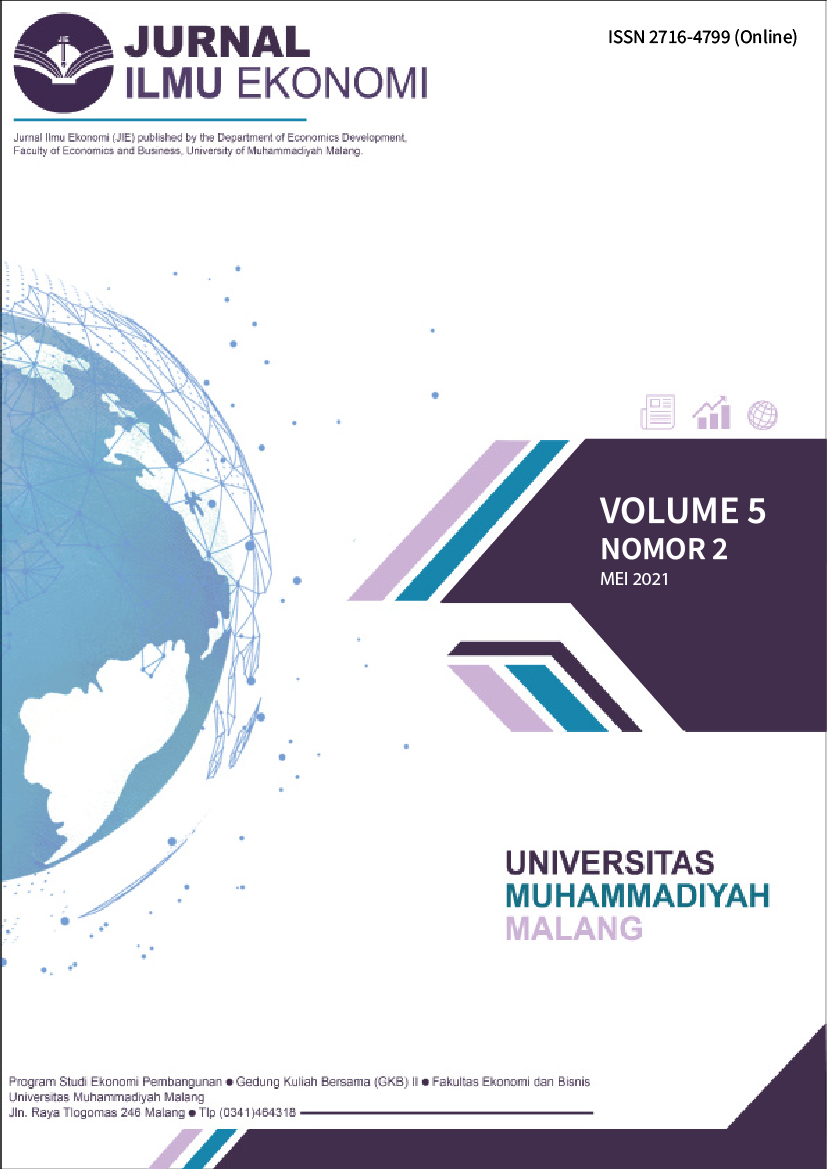PENGARUH SEKTOR PARIWISATA TERHADAP PENYERAPAN TENAGA KERJA DI PROVINSI JAWA TIMUR TAHUN 2012-2018
DOI:
https://doi.org/10.22219/jie.v5i2.14691Abstract
This aims of this reseach to analyze the effect of sector of tourism on absorption of labor in East Java Province in 2012-2018 (Study case: Regency/City in East Java Province). This research used secondary and the data obtained from the Tourism Office of East Java Province, the Office of Manpower and Transmigration of East Java Province and the Central Statistics Agency of East Java Province. The analysis technique in this research is panel data analysis wich is prossed using Random Effect Model (REM) . The dependent variable in this study is labor in the tourism sector in the Regency/City East Java Province in 2012-2018, while independent variables is the number of hotels, the number of restaurants, the number of tourism objects and number of tourists in the Regency / City of East Java Province in 2012. -2018. In this reseach, it is found that the variables number of hotels, the number of restaurants, the number of Tourism objects a positive and significantly. However, for the variable number of tourists a positive but does not effect absorption of labor in the tourism sector in the Regency / City of East Java Province.Downloads
References
Basuki, A. T. (2017). Analisis Regresi Dalam Penelitian Ekonomi dan Bisnis. Depok: PT. Rajagrafindo Persada.
Grafika, R. S. (2010). Undang-Undang Kepariwisataan UU No.10 Tahun 2009. Jakarta: Sinar Grafika Offset.
J, M. A. (2009). Kepariwisataan dan Perjalanan . Jakarta: Pt. Rajagrafindo Persada.
S, M. (2003). Ekonomi Sumber Daya Manusia Dalam Perspektif Pembangunan . Jakarta: Pt. Rajagrafindo Persada.
Simanjuntak, P. J. (1985). Pengantar Ekonomi Sumber Daya Manusia . Jakarta: Fakultas Ekonomi Universitas Indonesia.
Spillane, J. J. (1987). Ekonomi Pariwisata, Sejarah dan Prospeknya. Yogyakarta: Kanisius.
Sudarsono, Swasono, Y., Sulistyaningsih, E., & Suroto. (1988). Ekonomi Sumber Daya Manusia. Jakarta: Karunika Jakarta Universitas Terbuka.
Sumarsono, S. (2009). Teori dan Kebijakan Publik Ekonomi Sumber Daya Manusia . Yogyakarta: Graha Ilmu.
Suroto. (1992). Strategi Pembangunan dan Perencanaan Kesempatan Kerja . Yogyakarta: Gadjah Mada University Press.
Yoeti, O. A. (1996). Pengantar Ilmu Parawisata. Bandung: Percetakan Angkasa.
Kuncoro, H. (2002). Upah Sistem Bagi Hasil Dan Penyerapan Tenaga Kerja, JEP (Jurnal Ekonomi Pembangunan) Vol.7 No.1 45–56.
Astina, C., Hamzah, A., & Nasir, M. (2013). Pengaruh Pariwisata Terhadap Penyerapan Tenaga Kerja di Provinsi Aceh . Ilmu Ekonomi Pascasarjana Universitas Syiah Kuala Vol. 1 No. 4 , 14-24.
Hasmarini, M. I., Rahadi, M. Z., & Rosyid, A. (2018). Analisis Pengaruh Sektor Pariwisata Terhadap Penyerapan Tenaga Kerja di 5 Kabupaten/Kota Daerah Istimewa Yogyakarta Tahun 2011-2016. University Research Colloquimm 2018, Universitas Muhammadiyah Purwokerto, 1-7.
Punarbawa, M. A. (2016). Keterserapan Tenaga Kerja Pada Industri Parawisata di Kabupaten Buleleng Tahun 2011-2015. Program Studi Pendidikan Ekonomi Vol; 6 Nomor; 1 Tahun 2016, 1-12.
Saroji , R. P. (2018). Dampak Industri Parawisata Terhadap Penyerapan Tenaga Kerja Ditinjau Dari Perspektif Ekonomi Islam (Studi Pada Hotel, Biro Perjalanan Wisata, Kuliner dan Objek Wisata Kabupaten Lombok Barat). Ekonomi dan Bisnis Islam, Vol. 4 No.1, 61-70.
Tulumang, A. M., Kawung, G. M., & Layuck, I. A. (2019). Analisis Penyerapan Tenaga Kerja Pada Industri Pariwisata di Kota Manado . Jurnal Berkala Ilmiah Efisiensi Vol. 19 No.04, 1-12.
Guk Guk, D. R. (2018). Analisis Jumlah Obyek Wisata, Pendapatan Obyek Wisata, Jumlah Wisatawan Nusantara, dan Produktivitas Tenaga Kerja Terhadap Tenaga Kerja Sektor Pariwisata di Kabupaten Semarang Tahun 2013-2017. Skripsi.
Downloads
Published
How to Cite
Issue
Section
License
Copyright (c) 2019 Jurnal Ilmu Ekonomi JIE

This work is licensed under a Creative Commons Attribution-ShareAlike 4.0 International License.
Authors who publish with this journal agree to the following terms:
- For all articles published in the JIE (Jurnal Ilmu Ekonomi), copyright is retained by the authors. Authors give permission to the publisher to announce the work with conditions. When the manuscript is accepted for publication, the authors agree to the automatic transfer of non-exclusive publishing rights to the publisher.
- Authors retain copyright and grant the journal right of first publication with the work simultaneously licensed under a Creative Commons Attribution-NonCommercial-ShareAlike 4.0 International License that allows others to share the work with an acknowledgement of the work's authorship and initial publication in this journal.
- Authors are able to enter into separate, additional contractual arrangements for the non-exclusive distribution of the journal's published version of the work (e.g., post it to an institutional repository or publish it in a book), with an acknowledgement of its initial publication in this journal.
- Authors are permitted and encouraged to post their work online (e.g., in institutional repositories or on their website) prior to and during the submission process, as it can lead to productive exchanges, as well as earlier and greater citation of published work (See The Effect of Open Access).
This is an open access article and licensed under a Creative Commons Attribution-NonCommercial-ShareAlike 4.0 International License








